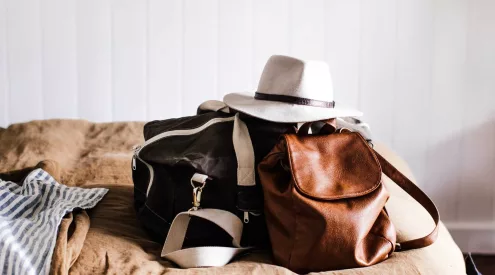Being locked inside has been a shock to all South Africa’s nature lovers, particularly marine enthusiasts. Although restrictions are loosened a little, it may be a while before ocean lovers can get back out on the water. Whale and dolphin watching, however, can be just as enjoyable from land.

Credit: Alex Vogel
With some of Cape Town’s most famous coastal walkways open for exercise during Level 3, this is a great chance to reconnect with nature, hone your whale watching eyes and even contribute to scientific data collection by logging your sighting on the Seafari app.
Early morning walks offer calm sighting conditions, optimum for spotting distant blows. Reductions in ocean traffic may even be increasing the diversity of life on offer, as whales and dolphins enjoy a welcome respite from ocean noise. Land-based whale watching is a brilliant family friendly activity and well worth getting up for!
With the start of the northward migration of humpback whales just around the corner and the famous southern right whales breeding within a stone’s throw of the shore line, the sea life is definitely not on lockdown.
There are important differences in the species seen, their location and timing between False Bay and the West Coast, largely due to differences in the water temperature and associated fish species.

Credit: Alex Vogel
Follow these top tips on your morning exercise:
Table Bay – Blouberg to Sea Point
Heaviside’s dolphins are endemic to the cool Benguela water of the west of southern Africa. These acrobatic dolphins are often seen very close to shore surfing the ‘back line’ or playing in the kelp early in the morning. Look out for their characteristic triangular fins, black and white markings which make them look like a baby killer whale. They are most common along the beaches north of Milnerton and off the coast of Greenpoint between the lighthouse and the V&A waterfront. Also off this coast, dusky dolphins (west coast only) and common dolphins (west and east of the peninsula) can be spotted – both of which tend to occur in much bigger groups and a little further from shore, usually just travelling along. Keep a look out for humpback whale blows on the horizon as well – these large whales have recovered in numbers and can be readily spotted year round but with a peak from November to February on the west coast where they are often feeding in spectacualrly large ‘super-groups’ of up to hundreds of animals.
Bantry Bay, Clifton and Camps Bay
Some of the best spotting is to be had along this stretch. The parking area and promenade at Queen’s Beach is excellent for humpback and Southern right whales. Dusky and common dolphins are also likely to pass within 1km of the shoreline. Further south, the elevated walk towards Clifton along Victoria Road allows uninterrupted views all the way towards Llandudno. Both Victoria Road and Kloof Road (1 road above Victoria Road) easily rate as one of the best spotting locations anywhere on the Cape Peninsula with one or all three of Cape Town’s most common whale species to be seen from here almost daily, weather permitting. Look for the dark patches, similar to a boat wake, that might indicate a pod of fast moving common dolphins, often no more than 2-3km from shore, sometimes closer. Dusky dolphins are very acrobatic with somersaults and backflips being part of their repertoire and making them identifiable from a distance.
Hout Bay and Chapmans’s Peak drive
Heaviside’s dolphins can be regularly seen very close to shore in the corner of Hout Bay underneath the Leopard Statue, with numbers peaking here in mid-morning (they move offshore at night to feed). Interestingly this is effectively the southernmost limit of the species distribution and sightings south of this are rare. Dusky and common dolphins can both been seen coming into the bay regularly. In winter a few southern right whales may come in close to shore and hang out in the shallows right off the beach. Bryde’s and humpback whales are best seen from the heights of Chapman’s peak. Bryde’s are occasionally seen feeding close to shore here but, most humpback whales here cut the corner and take a direct route from Karbonkel Berg to Kommetjie making a veritable ‘humpback whale highway’. Grab a bite to eat at any of the great Hout Bay restaurants after whale watching.
False Bay
Not only famous for penguins and leaping white sharks, False Bay formerly hosted several shore based whaling stations targeting southern right whales. As populations of right and humpback whales have recovered, both species are regularly seen in the bay, as well as the semi-resident Bryde’s whale which are present year-round, with numbers peaking in summer and autumn. Right whales in False Bay are mostly present during their breeding season from July to November and are readily identifiable from their characteristic ‘V’ shaped blow, lack of dorsal fin and all black tail. They tend to prefer the sandy floors off the northern beaches of False Bay, often clustering off Strandfontein, but they can also be seen hugging the coast when travelling.
During lockdown, walking along Main road between Fish Hoek to Kalk Bay or from St James to Muizenberg along the coastal walkway both offer great chances for sightings, well as catching Cape fur seals frolicking in the surf and great coastal bird watching. Fish Hoek is a prime location for close encounters with humpback and southern right whale. Keep a look out for feeding humpback whales from June onwards. Look towards Seal Island for a good chance of spotting common or bottlenose dolphins, often spotted in large groups traveling across False Bay and occasionally in association with Bryde’s whales. Also keep an eye out for killer whales, who enter False Bay not only for shark but also to hunt these dolphins.
About the authors:
Dr Tess Gridley and Dr Simon Elwen are marine biologists who run the only NGO in South Africa dedicated to marine mammal research: Sea Search Research and Conservation, in association with the University of Stellenbosch. Gridley’s research focuses on understanding dolphin and whale communication, as well as the effects of human activities on these majestic creatures. Elwen is an expert in marine mammal ecology and is currently running a dedicated programme of research on the killer whales in South Africa.
Alex Vogel: This Cape Town based amateur naturalist loves wildlife watching so much he commissioned his very own app to document sightings. The Seafari app is free, simple to download and recommended by scientists as the best way to document your sightings during lockdown and afterwards.
For more information, visit Sea Search Research And Conservation, or find them on social media.
Image: Getaway gallery


















